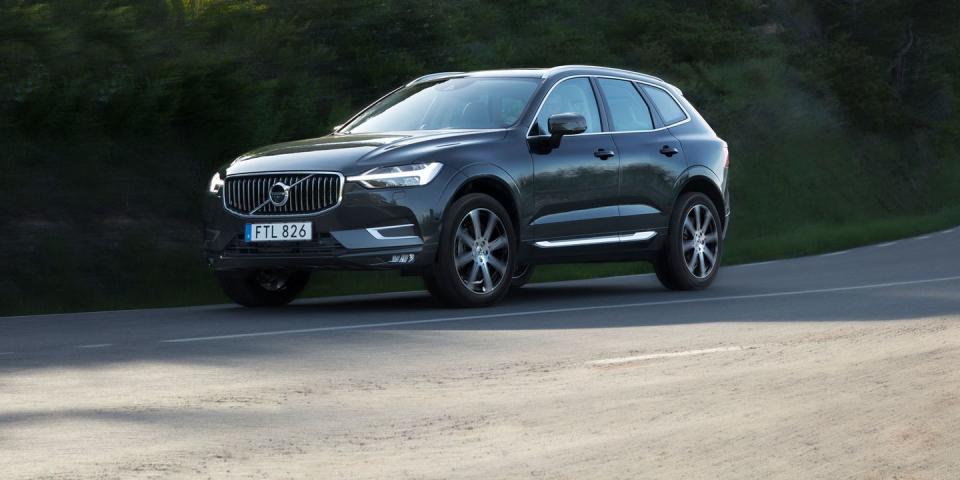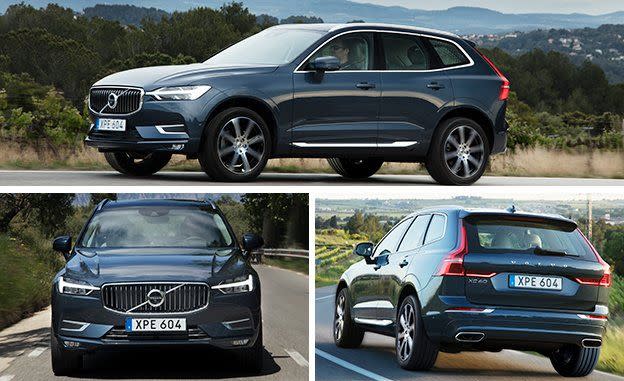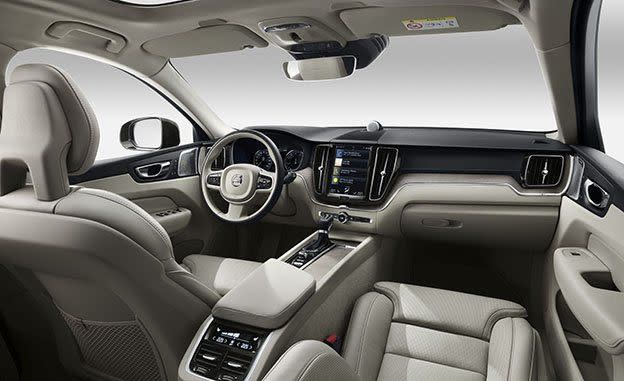2018 Volvo XC60 First Drive: The XC90's Mini Me

The redesigned Volvo XC90 kicked off the brand’s renaissance in 2015. Now that the 90-series family (XC90, S90, V90, V90 Cross Country) has been fully fleshed out, Volvo has launched the first of its mid-size 60-series models: the XC60. Like its still-to-come sedan and wagon brethren, the XC60 is built on the Scalable Product Architecture (SPA) platform that underpins the well-received 90-series. How closely does the XC60 emulate its elder sibling? Our first drive of Volvo’s smaller SUV—still the brand’s top-selling model at eight years of age—shows it to be very close indeed.
Family Resemblance
From the B-pillar forward, the XC60 could be mistaken for the bigger SUV. The upright fascia houses a similar grille, flanked by high-mounted headlights adorned with Volvo’s Thor’s Hammer sideways-T LED light graphic. The transverse-engine XC60 self-consciously sucks in its front overhang, and the hood traces a relatively straight line to the base of the windshield. Gaze rearward, however, and it’s clear this is the junior model. The beltline angles up rather than continuing in a length-enhancing straight line, the rear quarter-windows are smaller, and the liftgate is canted forward more aggressively.

Compared with its predecessor, the new XC60’s wheelbase has been stretched 3.6 inches, although at 112.8 inches it’s still 4.7 inches shy of the XC90’s. Overall length is up just 1.8 inches, so the overhangs have been trimmed. The vehicle also is 2.1 inches lower than before and fractionally wider, so the net effect is a sleeker profile and a more planted look.
The wheelbase stretch pays dividends in rear-seat space, a weak point of the outgoing model. The improvement is tangible; passengers sit on a cushion that’s comfortably up off the floor and enjoy generous rear legroom and headroom. Overhead, a panoramic sunroof is standard on all models and helps brighten the interior—too much, perhaps, for those in desert climes, as the mesh sunshade doesn’t totally block out the rays (which probably is less of a problem in Sweden).
The dashboard design, TFT instrument cluster, bladelike air vents, and vertically oriented touchscreen all do a convincing impression of the stylish XC90. The knurled-metal finish on the ignition knob and the drive-mode roller switch also are ported over from the 90-series cars. Elsewhere on the tall center console, two sliders cover two cupholders and two smaller cubbies, while the USB port is inside the hinged-top main bin. The Inscription model we drove was further luxed up with the $3000 Luxury Seat package, which includes ultrasoft leather, heating for the front and rear seats, a heated steering wheel, and ventilated front seats along with power cushion extensions, power-adjustable side bolsters, and a massage function for the front seats. So there’s a lot of seat adjustability, although it winds up feeling as if you are sitting on an assemblage of parts rather than one sculpted chair.

Volvo’s Sensus Connect 9.0-inch touchscreen has been slightly tweaked with a larger map for the navigation system, new fonts, and revised menu logic; it looks au courant, and the system is fairly easy to use after a little familiarization. We might prefer a knob for zooming (rather than pinch and pull) as well as physical controls for fan speed and temperature; as it is, the front and rear defrosters are the only HVAC controls with physical buttons. They join the audio system’s volume knob and tuning buttons on the minimalist interface.
The XC60 introduces a few new active-safety features. Oncoming-lane mitigation is a variation on lane-keeping assist: If a driver crosses the center line and the system detects an oncoming vehicle, it sounds an alarm and helps the driver steer the car back into its lane. Volvo’s City Safety automated emergency braking system can now help a driver steer around objects rather than just braking to avoid them; it works at speeds from 31 to 62 mph. And the new blind-spot assist system similarly can help steer the car back into its lane if the driver pulls out to pass when there’s a vehicle in the car’s blind spot or approaching quickly in the adjoining lane. It and rear cross-traffic alert are optional, while City Safety and oncoming-lane mitigation are standard.
Volvo’s Pilot Assist semi-autonomous driver-assist feature is optional here (part of the Convenience package), whereas it’s standard on the 90-series cars. It works at speeds up to 80 mph and is primarily meant for highway driving. The self-steering feature, which must be separately enabled after the adaptive cruise control is set, no longer needs a car in front to follow; it works well, steering smoothly and staying centered in the lane, although it does want the driver to keep a hand on the wheel.

Three and Three
As on the XC90, there are three trim levels: Momentum, R-Design, and Inscription. Even the base Momentum is well equipped. Priced at $42,495, it includes leather, a panoramic sunroof, the aforementioned City Safety and oncoming-lane mitigation, lane-keeping assist, LED headlights and taillights, 18-inch wheels, rain-sensing wipers, roof rails, 10-way power front seats, Sensus 9.0-inch touchscreen infotainment with Apple CarPlay and Android Auto, a backup camera, and a power liftgate. The R-Design, at $45,795, adds a firmer suspension tune, 19-inch wheels, drive mode settings, a 12.3-inch driver display, navigation, shift paddles, sport seats upholstered in leather and microsuede, metal mesh interior trim, and a black headliner, in addition to model-specific visuals including a gloss-black grille, and matte-silver mirror caps and window trim. The top-spec Inscription, priced at $46,295, adds four-zone automatic climate control, proximity-key entry, a hands-free tailgate, driftwood interior trim, and more exterior chrome.
Any of the three trims can be combined with any of the three powertrains, which are lifted directly from the 90-series models. The base (T5) engine is a turbocharged 2.0-liter inline-four with 250 horsepower and 258 lb-ft of torque. The T6 adds a supercharger to the mix, upping output to 316 ponies and 295 lb-ft. The T8 layers a plug-in-hybrid system atop the T6 hardware, making for a combined total of 400 horsepower and 472 lb-ft; its EV-only range, and all models’ EPA fuel economy, have yet to be released. An eight-speed automatic transmission is standard, as is all-wheel drive (front-drive models are expected to follow later).
Our time in the XC60 was confined to the T6. Its 316 horsepower moves this compact SUV energetically; we measured a 6.0-second zero-to-60-mph time with this powertrain in the XC90, and the roughly 500-pound-lighter XC60 should get there in 5.7. Throttle response doesn’t suffer any serious lag, although it’s not as precisely linear as a larger-displacement naturally aspirated engine. The boosted four gurgles pleasantly when pushed, with gentler acceleration accompanied by an occasional faint supercharger whine or turbo whistle. The eight-speed automatic calls little attention to itself, but only the R-Design has shift paddles; in the other models, one must slap the lever to the left to enter manual mode, then toggle forward and back for upshifts and downshifts.

Following SPA form, the XC60 now has a control-arm front and a multilink rear suspension, the front using coil springs while the rear gets a transverse composite leaf spring. The car we drove, however, was equipped with the available air springs and electronically adjustable dampers (an $1800 option). Volvo engineers claim that the new chassis’s front and rear roll centers are the same (they weren’t in the previous model), so the car doesn’t pitch forward in turns. Run through a succession of quick corners, and it feels sportier than before and well balanced for an SUV. Set in Dynamic mode, it also ably resists roll and admirably controls body motions. Switch to the default Comfort setting, and it’s a shade less impressive on both counts.
The smooth roads of sunny Spain, where our test drive took place, gave little indication of how the suspension copes with broken pavement, but the few bumps we did encounter suggest that this Volvo’s ride isn’t as brittle as you can find on some of its German competitors; that’s on the optional 20-inch wheels—available wheel sizes range from 18 to 22 inches, depending on trim level.

Volvo’s engineers didn’t want the XC60 to feel exactly like the XC90 from behind the wheel. Seeking greater driver engagement, they altered the steering of the XC60 for greater response immediately off-center. The result, though, is too quick, with an insufficient valley on-center. The twitchy sensation is exacerbated by an excess of boost, and effort fails to build as the wheel is turned. Here again, you’ll want to switch to the sportier drive mode, where the increased effort provides a better sense of straight ahead.
The steering is the only major letdown in an otherwise improved driving experience, at least in the version we drove. With the steel-and-composite-sprung chassis still to try—in standard and firmer R-Design form—not to mention the base engine and the plug-in-hybrid powertrain, there’s much more to investigate with the new XC60. It reaches dealerships in August, with the T8 following in September. So far, we’d say that this new kid is a faithful chip off the XC90’s block.
You Might Also Like

 Yahoo Autos
Yahoo Autos 